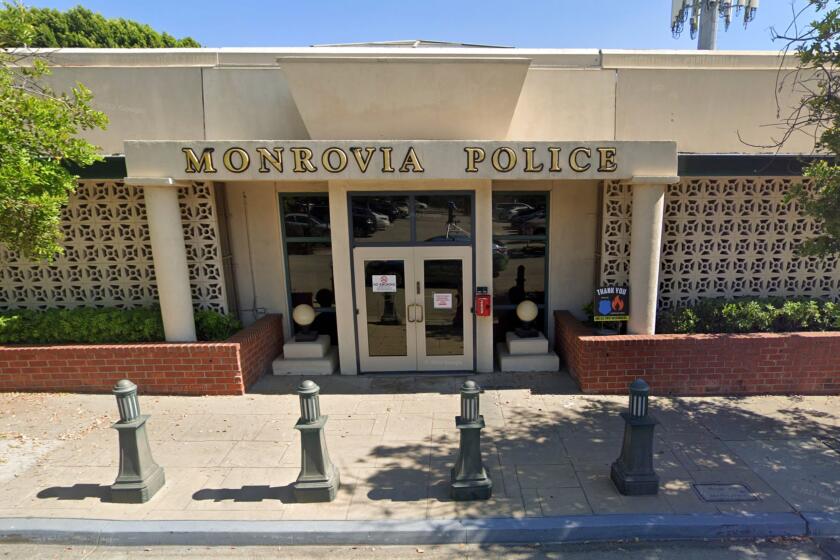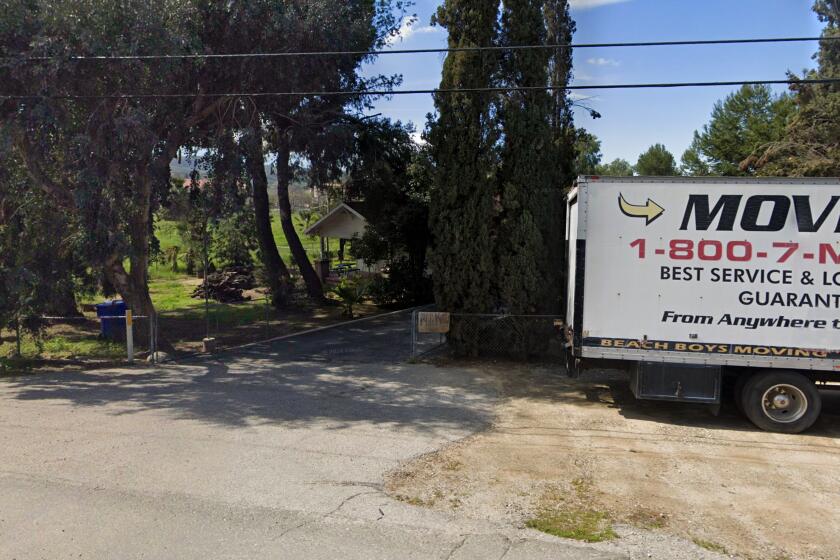Megan’s Law gives buyers another tool
Larissa Schultz and Ernie Duran looked beyond the usual considerations -- price, size and location -- when buying their Signal Hill condominium. The couple also researched the number of registered sex offenders reported as living in the area.
Since July 1, 1999, California law has required that purchase contracts for residential property serve as a notification to buyers of the availability of information on sex offenders. They also must include resources for information, such as county Web-based information as well as the state’s Megan’s Law database, a public notification and registration program named for a 7-year-old New Jersey girl who was raped and murdered in 1994 by a twice-convicted sex offender who moved into her neighborhood.
Because the law does not require sellers or agents to track down the number of registered sex offenders in any given area, June Barlow, vice president and general counsel of the California Assn. of Realtors, recommends that home buyers do their own research on sex offenders in an area before making a purchase.
Told by her real estate agent about the availability of such data, Schultz used the Los Angeles County Sex Offender Locator Web site and discovered there were five “serious” sex offenders living within one-tenth of a mile of the condominium she wanted to buy and 22 within a one-half mile radius.
Orange, San Diego and Riverside counties also provide this information online. The county sites use color-coded maps to show approximate locations of convicted sex offenders. However, unlike Megan’s Law online reports, which have more detailed information, county site maps can be searched only by ZIP Codes, addresses, schools or parks.
Residents statewide can access Megan’s Law information via computer terminals at justice and probation departments, college campus police stations and sheriff and police departments. The database allows viewers to search by name, ZIP Code, county, birth date, physical description and crime. It provides details on physical appearance, ethnic background, aliases, identifying marks and tattoos, sometimes with photos. It also describes the crimes committed, using penal code sections to identify and explain the types of crimes.
Offenders are categorized as “other” (someone convicted of indecent exposure, pornography or spousal rape), “serious” (a felony sex offender or misdemeanor child molester) and “high risk” (those with a higher recidivism rate, which means they may pose a greater danger to the public). According to the state Department of Justice, California is home to about 97,077 known sex offenders, including 17,047 in Los Angeles County and 3,119 in Orange County.
Armed with the facts and comfortable with their decision, Duran and Schultz, who don’t have children, purchased the Signal Hill home anyway. “If we had found a [known] sex offender living within the condominium complex, that may have affected our decision,” she said.
However, not every informed buyer is still willing to buy. For some, concerns about reduced home prices and safety issues related to living near a registered sex offender are deal breakers.
Will Brown, a real estate agent at Century 21 Better Homes in Santa Monica, said one buyer backed out of a deal after the family learned that three sex offenders lived within one mile of the sale property. The client bought a different home.
Barlow suggested that buyers use the inspection period to research the property themselves. As with any potential problem related to purchasing a home, buyers who locate known sex offenders living close to the property during the inspection period have the right to terminate sales contracts and receive full refunds of their deposits, she said.
When moving to an area with known sex offenders, Barlow said, buyers should consider factors such as the route their children might take to school, the nature of the offense and how far away the offender lives.
Moreover, Brown said buyers who have lived in an area for some time and are looking to buy nearby should not assume they know the neighborhood. “I can’t imagine investing $500,000 in a property and walking in there ignorant,” he said.
Since 1997, about 250,000 people have viewed the state’s Megan’s Law database, searching for information on employees, child-care workers, pastors, neighbors, landlords, tenants, coaches, youth counselors, teachers, friends, boyfriends, spouses and family members, according to Mike Van Winkle, state Department of Justice spokesman. And for the last six years, the state agency has provided Megan’s Law information at the Los Angeles County Fair in Pomona.
Camille Abdalla did not search the database before purchasing her Pasadena home in June 2000. While visiting the fair with her 2-year-old daughter in September, Abdalla and her husband, Anthony, checked the Megan’s Law database. They found 38 known sex offenders in their ZIP Code.
“I looked at every single picture, hoping that I wouldn’t see anyone I recognized,” she said. “I didn’t.”
But 21 of the 1,300 viewers who checked the database this year during the fair’s first three days did find someone they recognized, Van Winkle said.
Surprised by the numbers, Abdalla said she would do more research before purchasing another house and probably would not buy close to a registered child molester.
“We have a young family, and I wouldn’t want to have to constantly remind my daughter about the [offender] three doors away,” she said. “I don’t want to live in fear.”
Today, 28 states have some kind of Web-based sex offender information. However, the U.S. Supreme Court heard oral arguments last week in cases from Connecticut and Alaska that could determine how far states can go in keeping track of convicted sex offenders and sharing the information with the public.
California has been tracking adult sex offenders since 1944. In 1995, the California Sex Offender Information hotline, formerly known as the Child Molester Identification Line, provided a phone service with public information about registered sex offenders.
Megan’s Law database
In 1996, Megan’s Law expanded the service. Its first incarnation came in the form of a CD-ROM updated monthly and sent to law enforcement agencies. However, the U.S. Department of Justice reportedly published its last CD-ROM in June. Although some agencies still may be using CD-ROM data from June, Van Winkle said most Megan’s Law database computer terminals are electronically updated daily.
To access Megan’s Law, users must be 18 years old, have valid California driver’s licenses or ID and sign statements that they are not registered sex offenders and will not use the information to locate or harass registrants. The screening process weeds out sex offenders who may try to use the database to network with child-pornography rings and pedophiles, said Diane Webb, a detective in the Los Angeles Police Department’s Foothill Division.
Offenders are required to register with local law enforcement agencies within five working days of being released from jail or prison and annually within five days of a birthday, relocation or name change. They must comply with the law for the rest of their lives, and violent offenders must provide information every 90 days; transients every 60 days.
Critics say the system represents only a fraction of the nation’s actual sexual predators and does not provide accurate information on their locations.
However, Van Winkle said his research suggests 70% to 75% of registrants are in compliance and living at their stated location.
Still, because sex offenders are mobile, Barlow said it is important for buyers and residents to check the information on a regular basis.
Signal Hill condo buyer Shultz is sold on the idea. “In this day and age, I consider [Megan’s Law] to be a basic safety item, like checking for smoke detectors and crime statistics. It’s common sense, especially because the information is free and available.”
*
Locator resources
Sources of sex offender locator information include:
California Department of Justice: caag.state.ca.us/megan/index.htm.
California Sex Offender Information hotline: Callers must know the suspected offender’s name and one other piece of information such as an exact address, date of birth, California driver’s license number or Social Security number. There is a $10 fee for information on up to two people. (900) 448-3000.
KlaasKids Foundation Sex Offender Registration & Community Notification: klaaskids.org/pg-legmeg2.htm.
KlaasKids Foundation Megan’s Law in All 50 States: www.meganslaw.org.
County sites provide color-coded maps with basic information about approximate locations of serious and high-risk sex offenders. Users can search by ZIP Codes, addresses, schools or parks.
Los Angeles County Sex Offender Locator Web site: lacounty.info.
Orange County’s CommunityView for Megan’s Law: maps.digitalmapcentral.com/DSU/Megan/OCCA/OCSD.html.
San Diego County: www.arjis.org/SDCRPinMapEntry.html.
Riverside County: 216.57.210.151/riverside/jsp/index.jsp.
*
Michelle Hofmann is a Los Angeles freelance writer. She can be reached at michelle hofmann@earthlink.net.
More to Read
Start your day right
Sign up for Essential California for news, features and recommendations from the L.A. Times and beyond in your inbox six days a week.
You may occasionally receive promotional content from the Los Angeles Times.






